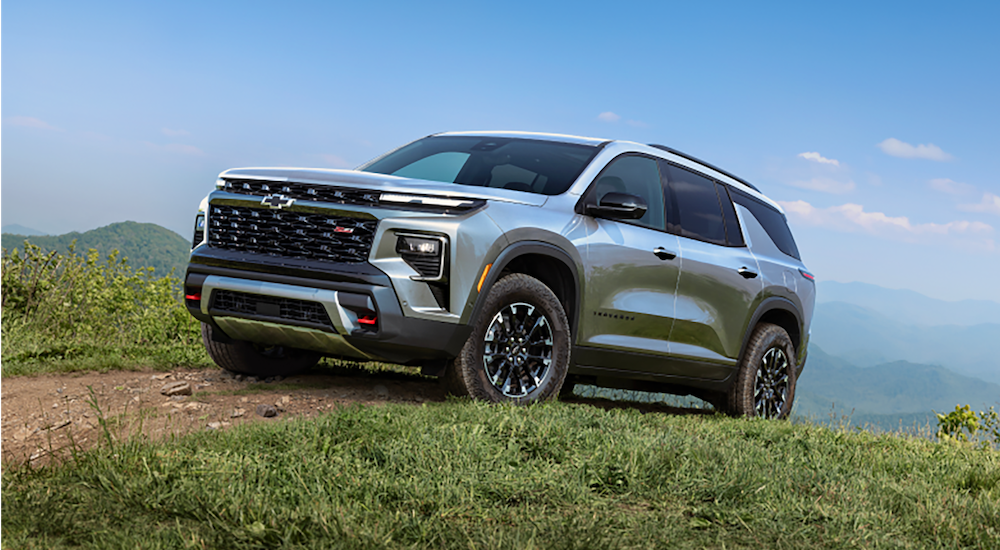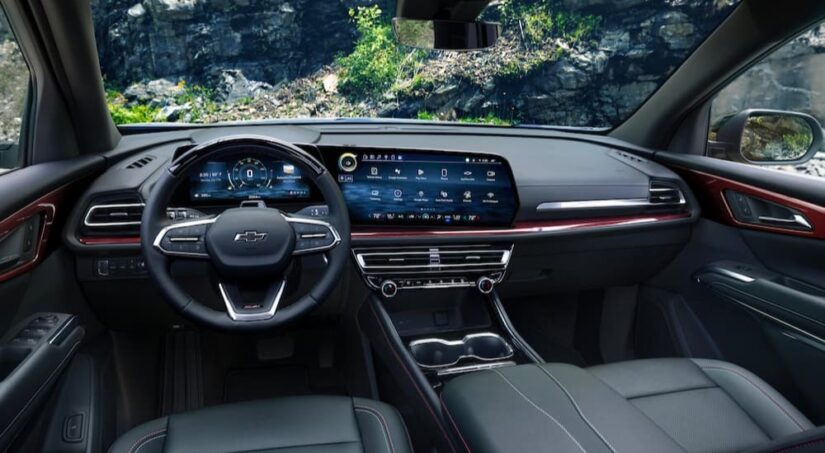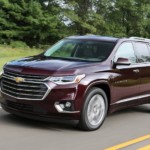When you take a look inside the new 2024 Chevy Traverse, you will notice that it boasts a large 17.7-inch touchscreen. It certainly looks impressive and futuristic. However, you may wonder if a touchscreen that size is actually practical. The answer is yes, but with a few caveats.
What sets the Traverse’s touchscreen apart from others is that it comes with physical controls for adjusting the climate and volume. This is a wise move since touchscreens can be difficult to navigate when driving on uneven roads; fingers tend to slip. Making the climate and volume controls more tactile allows drivers to easily manage these two aspects they manipulate most often.
In fact, the Traverse’s touchscreen is a great example of where future screens may go: large and smart but still offering physical controls. As it stands, touchscreens that are entirely touch come with some downsides, while controls that are entirely physical seem out of date and lack an exciting flair. So, what is a buyer to do when considering a new purchase?
Let’s take a glance at the touchscreen, where it came from, and where it might be headed…
Why Did Touchscreens Catch On?
In the past, features like radios and climate control were not immediately incorporated into cars. Similarly, the integration of touchscreens and other technological advancements took time and continued to evolve. Around the 1980s, as personal computers became more prevalent, a few car manufacturers began experimenting with digital technology in their vehicles.
Buick’s Riviera, introduced in 1986, was one such pioneer. While impressive for its time, the unfamiliarity with this technology prevented it from becoming widely adopted by other manufacturers; it was seen more as a novelty than something that would revolutionize car interiors—and that’s what it remained for some time.
As time went on, though, there were signs that a touchscreen resurgence might be on the horizon. Drivers became accustomed to receiving more information, such as with backup cameras, so a more intelligent infotainment system suddenly did not seem so foreign. At home, folks had gotten accustomed to having their own computers, and cell phones were on the rise. Why not have some of those advancements in the car? Suddenly, a digital interface did not seem superfluous.
BMW was first on the scene with its iDrive technology. Its initial 2001 iteration does not look all that similar to the touchscreens we know and love today, but it was an important first step; gradually, other automakers did their best to match the iDrive.
The tech would fail without consumer approval—and initially, there was some hesitation on the part of both consumers and the automotive press. Would digital information systems be too overwhelming to operate? Would they be too distracting? Would they constantly break? All valid concerns, but the proof is in the pudding: digital information screens became popular.
Part of it, admittedly, is because they looked cool. Any driver who had a touchscreen in their car looked like a driver who had access to the newest, most groundbreaking tech. Who wouldn’t want that?

The Benefits of the Touchscreen
One of the best benefits of touchscreens in cars is having advanced safety and navigation features at your fingertips. With digital driver information screens and touchscreens, drivers have access to more information about their vehicle’s condition, which is especially important for truck drivers. Navigation is far easier as the route can be displayed on the screen, eliminating the need for drivers to constantly check a map, or spring for a third-party GPS system that suctions to the windshield and is super small and pixelated.
Another advantage of touchscreens is their entertainment value. Drivers can connect their devices to Android Auto or Apple CarPlay to listen to their favorite playlists or tune in to the latest news on SiriusXM radio. This can be a great way to pass the time on long drives, helping drivers stay alert and avoid fatigue, which is especially valuable for those who travel alone.
Most touchscreens help drivers connect through Bluetooth, too, which encourages hands-free driving. You can chat with colleagues, clients, family, and friends while still having both hands on the wheel. Making it illegal to hold a cell phone while driving reduced the issue of distracted driving, and this would’ve been nearly impossible to enforce without Bluetooth technology becoming ubiquitous.
The Possible Downsides of the Touchscreen
When you ask folks about touchscreen downsides, they are likely to mention it might serve as a distraction. Yet, if you ask them if they are personally distracted, they are just as likely to say no. Car manufacturers have gotten far better at having touchscreens adapt to current lighting conditions, dimming and brightening as needed, and many manufacturers have designed their displays to look sharp without high-contrast or moving images that would easily distract drivers in their periphery.
For example, the 2024 Chevy Traverse‘s touchscreen may be huge, but it is not distracting; it is intuitive but not overbearing. Touchscreens are more often distracting due to poor design, not size, and today, across the industry, we’re seeing larger touchscreens with clearer displays and better design.
The actual process of touching the screen can be a disadvantage and is where most problems reside today. The touchscreen makes sense for putting in directions—an action that requires a lot of input—but when it comes to changing the vehicle’s climate or adjusting the volume of music, having to interact with a touchscreen while driving ends up being more frustrating for drivers than when they could just turn a knob. Tactile controls might seem mundane—and certainly do not look as nifty—but there are certain circumstances where they are objectively superior.
Lastly, as with any technology, those drivers who are not savvy with touchscreens may run into trouble operating such an infotainment system. In fact, some touchscreens feature so many apps that even those keen on the latest tech find themselves overwhelmed—perhaps even lost in the options. Gradually, car manufacturers have been learning that there’s such a problem as too much of a good thing.

Where Do Touchscreens Go From Here?
Touchscreens are here to stay—at least to some extent. The one on the 2024 Chevy Traverse might seem like proof since it’s one of the largest on the market today, yet it concedes some of the control to tactile knobs for volume and climate control. This is an insight into how technology will advance, indicating that Chevy is responding to drivers’ requests for simpler controls. Thus, in the future, we can expect a continuing combination of tactile and digital controls. If you’re in the market for a new car, choosing one that offers this blend could help you manage the infotainment system with greater ease.
So, touchscreens will remain, but they’ll likely have to evolve to deal with some drivers’ concerns. And, while sizes will vary, it’s also likely that manufacturers won’t want to put too many digital screens inside their vehicles. There has been some talk of expanding the number of screens, with some manufacturers saying we could cover the windows with displays, but it’s hard to imagine such a case becoming a reality; some of the fun of driving might be lost if everything around you glows with information.



